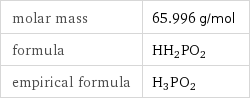Input interpretation

HH2PO2 (chemical compound)
Basic properties

molar mass | 65.996 g/mol formula | HH2PO2 empirical formula | H_3P_O_2
Elemental composition

Find the elemental composition for HH2PO2 in terms of the atom and mass percents: atom percent = N_i/N_atoms × 100% mass percent = (N_im_i)/m × 100% Plan: • Write the chemical formula and gather atomic masses from the periodic table. • Determine values for N_i, m_i, N_atoms and m using these items. • Finally, compute the percents and check the results. Use the chemical formula to count the number of atoms, N_i, for each element and find the total number of atoms, N_atoms, per molecule: | number of atoms H (hydrogen) | 3 P (phosphorus) | 1 O (oxygen) | 2 N_atoms = 3 + 1 + 2 = 6 Divide each N_i by N_atoms to calculate atom fractions. Then use the property that atom fractions must sum to one to check the work: | number of atoms | atom fraction H (hydrogen) | 3 | 3/6 P (phosphorus) | 1 | 1/6 O (oxygen) | 2 | 2/6 Check: 3/6 + 1/6 + 2/6 = 1 Compute atom percents using the atom fractions: | number of atoms | atom percent H (hydrogen) | 3 | 3/6 × 100% = 50.0% P (phosphorus) | 1 | 1/6 × 100% = 16.7% O (oxygen) | 2 | 2/6 × 100% = 33.3% Look up the atomic mass, m_i, in unified atomic mass units, u, for each element in the periodic table: | number of atoms | atom percent | atomic mass/u H (hydrogen) | 3 | 50.0% | 1.008 P (phosphorus) | 1 | 16.7% | 30.973761998 O (oxygen) | 2 | 33.3% | 15.999 Multiply N_i by m_i to compute the mass for each element. Then sum those values to compute the molecular mass, m: | number of atoms | atom percent | atomic mass/u | mass/u H (hydrogen) | 3 | 50.0% | 1.008 | 3 × 1.008 = 3.024 P (phosphorus) | 1 | 16.7% | 30.973761998 | 1 × 30.973761998 = 30.973761998 O (oxygen) | 2 | 33.3% | 15.999 | 2 × 15.999 = 31.998 m = 3.024 u + 30.973761998 u + 31.998 u = 65.995761998 u Divide the mass for each element by m to calculate mass fractions. Then use the property that mass fractions must sum to one to check the work: | number of atoms | atom percent | mass fraction H (hydrogen) | 3 | 50.0% | 3.024/65.995761998 P (phosphorus) | 1 | 16.7% | 30.973761998/65.995761998 O (oxygen) | 2 | 33.3% | 31.998/65.995761998 Check: 3.024/65.995761998 + 30.973761998/65.995761998 + 31.998/65.995761998 = 1 Compute mass percents using the mass fractions: Answer: | | | number of atoms | atom percent | mass percent H (hydrogen) | 3 | 50.0% | 3.024/65.995761998 × 100% = 4.582% P (phosphorus) | 1 | 16.7% | 30.973761998/65.995761998 × 100% = 46.93% O (oxygen) | 2 | 33.3% | 31.998/65.995761998 × 100% = 48.48%
Mass fraction pie chart

Mass fraction pie chart
Potential structures

| SMILES:OPO | SMILES:OOP (structures consistent with atomic valence requirements, may not be chemically stable)